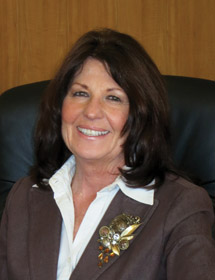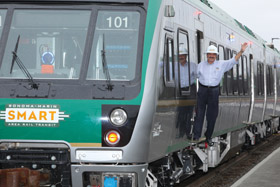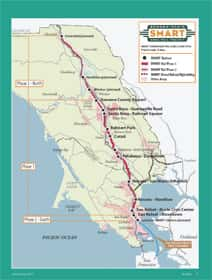“Eventually everything connects—people, ideas, objects. The quality of the connections is the key to quality per se.” —Charles Eames
 If you commute between Sonoma and Marin counties on a routine basis, then you know what it’s like to spend a good portion of your day on the heavily congested Highway 101 corridor. Chances are you’re up in the early morning hours, to-go coffee in hand, and have learned to just deal with the unpredictable traffic patterns along the 70-mile stretch. There’s also the wear-and-tear on your car, parking challenges and fees as well as the inevitable stresses and hassles of commuting. As for the environment? One thing’s for sure, all that traffic isn’t helping the green cause.
If you commute between Sonoma and Marin counties on a routine basis, then you know what it’s like to spend a good portion of your day on the heavily congested Highway 101 corridor. Chances are you’re up in the early morning hours, to-go coffee in hand, and have learned to just deal with the unpredictable traffic patterns along the 70-mile stretch. There’s also the wear-and-tear on your car, parking challenges and fees as well as the inevitable stresses and hassles of commuting. As for the environment? One thing’s for sure, all that traffic isn’t helping the green cause.That’s why nearly 70 percent of voters of Marin and Sonoma supported Measure Q in 2008 to create a train that connects the two counties. And that was the beginning of the Sonoma-Marin Area Rail Transit, more commonly known in the North Bay as SMART.
Imagine boarding a train, coffee cup and the morning newspaper (or your latest copy of NorthBay biz magazine) in-hand and enjoying a shorter, faster commute with no traffic hassles. It’s a dream on track and about to come true.
Currently, SMART service is scheduled to begin in late 2016 on Phase 1 of the project. This stretch of rail will cover 43 miles, from downtown San Rafael to Airport Boulevard, north of Santa Rosa. The total projected cost for Phase 1 is about $428 million. And though it’s been an exciting and unique experience for the SMART team and board members, it’s a project that’s had its challenges.
 The challenges
The challenges
While in the midst of creating SMART, the team faced two major challenges. First, when the worst financial crisis since the Great Depression hit the North Bay (as well as the rest of the nation), the board of directors spearheading SMART had to rethink its strategy. It was 2009, it was just getting started and it suddenly had less money to work with.
Nevertheless, the group forged ahead. “The facts that SMART was collecting taxpayer money and that the voters approved the project twice provided the impetus,” says Marin County Supervisor Judy Arnold (District 5), a board member for SMART.
“To their credit, the board members took a bold step,” says Farhad Mansourian, general manager of the SMART project. “It was a difficult decision. They decided to build what they could afford, so they agreed to phase-in the project.” According to Mansourian, the board was clear about its purpose: build a railroad and bike path, and work within the budget. “Not every board has that clarity,” he adds.
The bold move worked. “We’re just now finishing Phase 1, which will serve 75 percent of the overall population,” says Mansourian. What’s more, the SMART team is dedicated to keeping the project moving forward. “We’re committed to finding money—every dollar and grant—and we’re not done until we get to Cloverdale and Larkspur and build a multi-purpose path [along the entire route],” says Mansourian.
The second major challenge was creating a rail and pathway—while creating the organization that would operate it—without many templates to follow.
 That’s what made SMART new, exciting and unique, says Mansourian, but it was also an enormous effort pulling it together. “Typically, when the government does a project, there’s a structure in place [to follow], but we’re constructing a large, complex project—that voters approved—while building an entire agency that will operate it,” says Mansourian. “It’s like drinking water out of a fire hydrant while building the entire water system, from pipeline to reservoir to storage tanks. And we’ve been successful.”
That’s what made SMART new, exciting and unique, says Mansourian, but it was also an enormous effort pulling it together. “Typically, when the government does a project, there’s a structure in place [to follow], but we’re constructing a large, complex project—that voters approved—while building an entire agency that will operate it,” says Mansourian. “It’s like drinking water out of a fire hydrant while building the entire water system, from pipeline to reservoir to storage tanks. And we’ve been successful.”When it’s complete, linking segments constructed by SMART with existing segments and other planned projects will create one of the longest, continuous bicycle-pedestrian pathways in the country. This rail-and-trail pathway allows for longer, multi-modal trips, which means you can walk or ride your bike part way, and then catch a ride on the rail the rest of the way to your destination.
Bike-and-trail synergy
Around SMART headquarters, this concept of multi-modal trips is known simply as “bike-and-trail synergy.” What caused the SMART board to feature a bike-and-trail path along with rail service?
Years ago, the county of Marin was among a group of six municipalities in the United States to participate in a $100 million federal Non-motorized Transportation Pilot Program (NTPP) created by the 2005 federal transportation bill, explains Arnold. (Other municipalities included Sheboygan County, Wisc., along with the cities of Columbia, Mo., and Minneapolis, Minn.)
“Each community was awarded up to $25 million to spend over four years to determine how walking and biking can meet more of their areas’ transportation needs,” she says. As the legislation stated, the goal was to represent a major portion of the transportation solution within selected communities. “Marin was clearly the leader in creating separate bike paths where possible, promoting bike riding to schools and ensuring that new development included bike access and parking. To include bikes in [the] rail plan was never doubted,” says Arnold. “The bicycle community worked very hard for the passage of SMART and the partnership continues to this day.”
Positive train control
The rail industry is regulated by many federal agencies. Congress mandated that, by the end of 2015, all existing and new freight- and passenger-train services design and install added safety measures and specifically called for Positive Train Control (PTC). Each SMART train will be equipped with PTC technology and its associated equipment, which will enforce safe speeds as it travels throughout the SMART system. (PTC is a system of functional requirements for monitoring and controlling train movements that provides a number of benefits, such as train separation and collision avoidance; line speed enforcement; temporary speed restrictions and rail worker safety.)
The cost for PTC and its associated signals, communication and related infrastructure is $50 million, a formidable expense but worth the price, according to the SMART team. In addition to PTC, SMART will also feature Crash Energy Management (CEM). “When former SMART Director Charles McGlashan and I brought a video to the full SMART board of a train with Crash Energy Management—and one without it—there was no question whether to include it,” says Arnold. “When the board saw the difference, it voted to install CEM, which we’ve done.”
“SMART will be the first new service in the nation to have PTC from day one, and it’s huge for safety,” says Mansourian. “PTC will stop the train if it’s going faster than it’s allowed to or designed for, or if the engineer isn’t paying attention. That’s how sophisticated it is.” What’s more, he says, PTC could’ve prevented the Philadelphia train derailment earlier this year, if speed was the only factor for derailment. (See “The Philadelphia Train Derailment,” below.)
According to an online search, the main concept in PTC is that the train receives information about its location and where it’s allowed to safely travel, also known as movement authorities. Equipment onboard the train then enforces this, preventing unsafe movement. “Our PTC system is integrated with Signal System, and all trains running in the commuter territory will be controlled,” says Mansourian.
Passenger cars
Once Phase 1 is complete, there will be seven, two-car train sets of self-propelled Diesel Multiple Units (DMUs). The engines are environmentally friendly and meet strict “Tier 4” requirements set by the Environmental Protection Agency. The passenger cars are manufactured in Rochelle, Ill., by Sumitomo Corporation in the Americas.
 Each passenger car is a two-car train set, which can safely carry up to 320 passengers seated or standing. A third car was recently approved for three of the fleets, which will boost that capacity to 450 passengers, seated or standing. Each train can accommodate up to 24 bicycles on board (depending on the mix of bikes, wheelchairs, strollers and such).
Each passenger car is a two-car train set, which can safely carry up to 320 passengers seated or standing. A third car was recently approved for three of the fleets, which will boost that capacity to 450 passengers, seated or standing. Each train can accommodate up to 24 bicycles on board (depending on the mix of bikes, wheelchairs, strollers and such).The accompanying pathway provides access to rail stations and by accommodating bikes, SMART allows for longer multi-modal trips that would be tough on a bike alone.
Schedules and fares
Trains will operate in both directions every 30 minutes during peak commute hours, with a mid-day trip and weekend service planned as well. A train ride from Santa Rosa to San Rafael will take about an hour. Beverages such as coffee, tea and soft drinks will be served on commuter trains; SMART officials are studying whether to serve alcoholic beverages and are also working with major employers in the North Bay to discuss the logistics of getting commuters in and out of stations most efficiently.
An area-wide method of fare collection will be used, regardless of which transit system commuters are traveling. Fares and discounts will be comparable with other transit options, and discounts for transfers between transit modes will also be available. Clipper cards will be used for the zone-based fare collection.
On the horizon
Currently, construction workers and crew will spend the remainder of this year finishing Phase 1, says Mansourian. The Operations and Maintenance Facility (OMF) and the Diesel Multiple Unit train wash commissioning are scheduled for completion this summer.
Early next year, the SMART crew will begin testing the system. “We’ll spend the first 10 months of 2016 testing, and we’ll open the doors when we’re confident everything is as perfect and safe as it can be,” says Mansourian.
What can commuters expect at the end of next year? “If you’re currently stuck on Highway 101 and have no other choice, we’ll get you to your destination faster, while you’re drinking a latté. You’re sure to arrive to your destination in a lot better mood,” he adds.
Once Phase 1 is complete, planning for the next phase will begin; it will connect downtown San Rafael to a location across the street from the Larkspur Ferry terminal. Funding for this extension of the SMART Rail & Pathway was included in President Obama’s $4 trillion budget in February, giving SMART authorities a source of capital to complete the southern end of the line. The $20 million in proposed funding through the Federal Transit Authority’s Small Starts program, plus and additional $20 million regional grant that was approved last year would fully fund the 2.2-mile line from downtown San Rafael to the Larkspur ferry terminal. It will cost $42 million for two miles of rail-and-path, according to Mansourian.
“Our plan is to get to Larkspur by the end of 2016. We’re always looking for grants. Our next stop after Larkspur is Windsor, then Healdsburg and, finally, Cloverdale,” says Arnold. “Whenever there’s an opportunity for new money, SMART is there.”
(At press time, Smart learned it’s one of 14 transit agencies to receive $11 million in CAO and trade money; funds will be used to purchase another set of cars.)
A game changer
SMART will be a key game changer in the North Bay in the years ahead. “[The] SMART rail is a game changer because, in the midst of the worst recession in the United States, the residents of Marin and Sonoma looked toward the future and saw the need for another alternative to single-occupancy automobiles and voted to pay for it with their sales tax dollars to help alleviate the growing traffic congestion on 101,” says Arnold.
SMART will connect residents and visitors with jobs, education, recreation and services. Currently, more than 75 percent of commuters in the North Bay travel either within or between the two counties to get to work. SMART experts estimate the new rail and path will carry 5,000 passengers per day.
Additionally, Sonoma County alone draws more than 8 million tourists per year from all over the world. “Our generation is watching the creation of the spine of the North Bay. We’re going to become the conduit between Wine Country and the tourism market,” says Mansourian. “How much is that worth to our community? You go figure.”
And what do the creators of SMART want North Bay commuters to know in the decades that follow? “That early in the 21st century, a coalition of visionaries from Marin and Sonoma counties saw the need to relieve traffic congestion and to use a rail line that had been preserved. In 2011, SMART put out the word on public venues: There’s a Train Coming to Town,” says Arnold. By the end of 2016, it will arrive.
Saving the Planet
The SMART train is estimated to reduce greenhouse gases by about 31 million pounds per year. (This number does not include emissions reduced by strengthening the overall transit network or emissions reduced as a result of the bicycle and pedestrian path.)
What’s more, the construction is focusing on sustainability. Old ties, rail and bridge segments are being recycled or saved for reuse. The new rail is made primarily from recycled content.
Made in the USA
The SMART Railway and Pathway project is home grown.
• The passenger trains are being assembled in Rochelle, Ill.;
• The ties are being made in Spokane, Wash.;
• Rails are being manufactured in Pueblo, Colo.; and
• Ballast (gravel and course stone) will be provided by local suppliers.
Timeline
The last passenger rail service in the North Bay was in 1958 in downtown San Rafael. Here’s a timeline of what’s taken place to get a commuter service back on track in the North Bay.
1970s-1980s The Northwestern Pacific right-of-way brought into public ownership by local jurisdictions
1992 Feasibility study of Intercity Rail Passenger Service (Wilbur Smith Report)
1995 Sonoma Marin Multimodal Transportation and Land Use Study (Calthorpe Report)
2008 Measure Q passes in November
2009 Worldwide recession reduces revenue
2010-11 SMART board decides to phase-in the project, based on available funds
2012 First construction contract awarded
2013 Construction on Phase 1 begins in summer
Late 2016 Passenger service will begin on Phase 1, which includes a 43-mile stretch, running from downtown San Rafael to Airport Boulevard, north of Santa Rosa
SMART facts
Five major construction contracts are infusing more than $250 million into the economy, delivering a significant infrastructure improvement project in the North Bay. Here are a few key operating details about the new Sonoma-Marin Area Rail Transit.
• Top speed is 79 mph.
• 30 trains per day (15 in each direction).
• Half hour headways during peak periods, this means if you’re standing at any given station, you can catch a train going south or north every 30 minutes during designated times.
• Six, two-car train sets in service.
• Two-way operation on a single-track railroad, using strategically located “passing sidings” or multiple main track segments, which means in four places trains will pass each other based on a strategically developed length and location and the designated speed.
Platform Locations
Once the SMART Rail and Pathway project is complete, there will be 10 platform locations along the 70-mile corridor. Stations will comply with the Americans with Disabilities Act (ADA), allowing for level boarding. What’s more, there will be Express Connector bus service between Santa Rosa and future station locations in Windsor, Healdsburg and Cloverdale, and between Downtown San Rafael and Larkspur. Here’s a list, showing where the platforms will be located:
Santa Rosa
• Airport Boulevard
• Guerneville Road
• Railroad Square
Rohnert Park
• Rohnert Park Expressway
Cotati
• East Cotati Avenue
Petaluma
• Downtown
Novato
• Novato North (San Marin/Atherton)
• Novato South (Hamilton)
San Rafael
• Marin County Civic Center
• Downtown
The Philadelphia Train Derailment
PTC might have prevented the Philadelphia train derailment in May, when an Amtrak Northeast Regional train bound for New York City derailed and crashed on the Northeast Corridor in the Port Richmond neighborhood of Philadelphia, according to SMART General Manager Farhad Mansourian.
At the time, there were 238 passengers and five crew members on board. Eight people were killed and more than 200 were injured; 11 were critically injured. The train was traveling at 102 mph in a 50 mph zone of curved tracks when it derailed. According to an online search, officials said the incident might have been prevented by a computerized, speed-limiting system that was operational elsewhere on the Northeast Corridor, but activation at the site had been delayed due to regulatory requirements.
Author
-

Karen Hart is the editor of NorthBay biz magazine, keeping her finger on the pulse of the North Bay, directing content and leading day-to-day operations of the editorial team. An award-winning writer, Karen brings more than 30 years of experience to the position. She is a member of the California Writers Club, and serves on the Journalism Advisory Council at Santa Rosa Junior College. She moved to Sonoma County in 2000, and she’s here to stay.
View all posts



